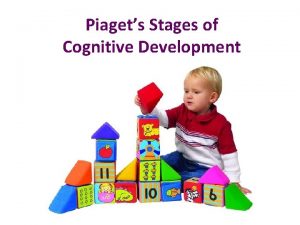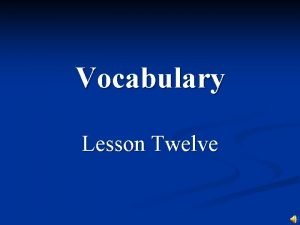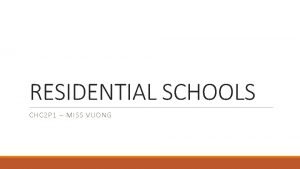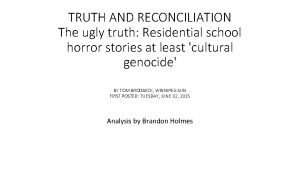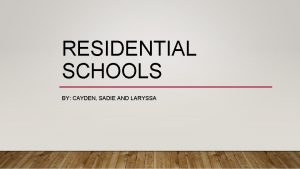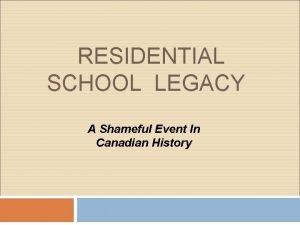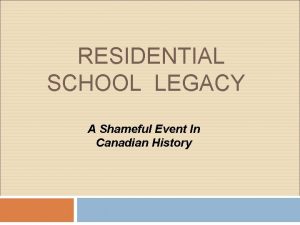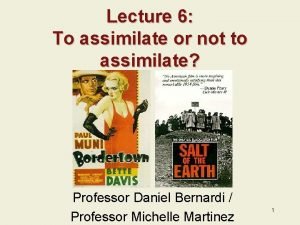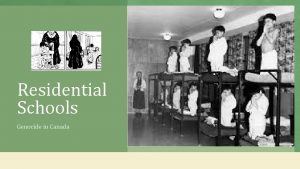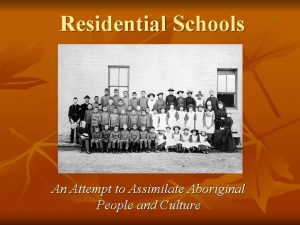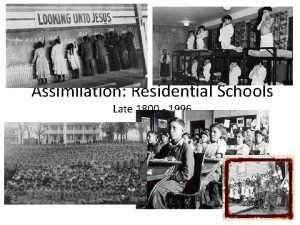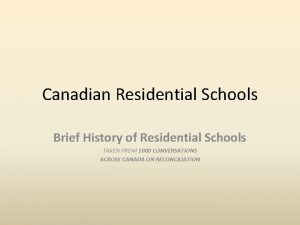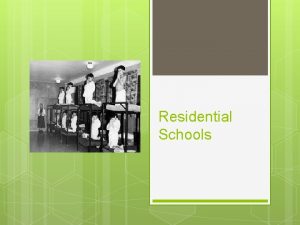RESIDENTIAL SCHOOLS English 11 Purpose To assimilate First











- Slides: 11

RESIDENTIAL SCHOOLS English 11

Purpose ■ To assimilate First Nations children into a Christian lifestyle and European work habits ■ In 1920 it was made into law that all First Nations children were to attend Residential schools if there was no Day school near their home.

Quote from 1920 ■ “Our object is to continue until there is not a single Indian in Canada that has not been absorbed into the body politic, and there is no Indian question, and no Indian department. ” ■ Stated by Duncan Campbell Scott – Deputy Superintendent General of Indian Affairs

Why did First Nations Children Go? ■ It was the law. ■ Indian Agents on the reserves would withhold food and benefits from those who did not go. ■ Children were forcibly taken by priests, Indian agents or police officers and sent on buses or cattle cars to schools. ■ Some families did resist despite the consequences. ■ After Grade Six only about 3% of First Nations children remained in school.

Life at a Residential School ■ It was a boarding school ■ Often a long way from the child’s actual home. ■ Sometimes students could go home for the summers. ■ Often their meals would be rotten or lacking in quantity. ■ Usually run by a church. The teachers would be nuns or priests.

Rules ■ The children were taught that their culture, their spiritual beliefs, their language, and their clothes were inferior and wrong. ■ The children were not allowed to speak their native language. If they were caught doing so they would be beaten. ■ The children were given new English names. ■ Their hair was cut. ■ They were to wear different clothes.

Lessons ■ The day would start with chapel. ■ In the morning there would be lessons on reading, writing, arithmetic and religion. ■ Discipline was harsh. You could be punished for poor work or learning too fast.

Lessons Continued ■ In the afternoon students would be given manual chores. ■ Thus, their education was inferior. ■ It was believed that First Nations children were only fit for menial labour so a good education wasn’t necessary.

Abuse ■ Some schools had dedicated staff ■ But in other schools teachers used their position to abuse the students emotionally, physically, and sometimes sexually. ■ The children were helpless.

Impact ■ When the children were taken from their homes the communities, they were left in a state of shock and despair. ■ Some turned to alcohol. ■ First Nations children were deprived of normal family life and did not learn how to be parents. ■ Children were taken from their home, culture, land, community…Their identity was torn from them. ■ Many children who went to Residential schools never returned because they died from disease, beatings, suicide, or failed escapes.

Residential Schools ■ In 1920 it was compulsory for First Nations children to attend Residential or Day schools. ■ The last one closed in 1996 ■ “Indian Residential Schools Unit. ” Assembly of First Nations. Nov. 29, 2010. http: //www. afn. ca/residentialschools/history. html.
 Concrete operational stage
Concrete operational stage Assimilate mentally
Assimilate mentally Before and after residential schools
Before and after residential schools Tuberculosis in residential schools
Tuberculosis in residential schools Residential schools canada
Residential schools canada Residential schools horror stories
Residential schools horror stories Residential schools
Residential schools Residential school photos show legacy
Residential school photos show legacy Residential schools in canada map
Residential schools in canada map Power schools huntsville city schools
Power schools huntsville city schools Safety target reach schools
Safety target reach schools Sentence purpose
Sentence purpose
